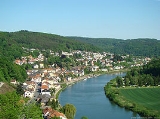
Neckarsteinach
Encyclopedia
The four-castle town of Neckarsteinach lies on the Neckar
in the Bergstraße district
in the southernmost part of Hesse
, Germany
, 15 km east of Heidelberg
.
_1896.jpg) Both by way of transport and culture, Neckarsteinach’s location in the Neckar valley more tightly links it with the North Baden area around Heidelberg than with the rest of Hesse. It is furthermore one of the municipalities belonging, like the ones in the surrounding districts, to the Rhine Neckar Area
Both by way of transport and culture, Neckarsteinach’s location in the Neckar valley more tightly links it with the North Baden area around Heidelberg than with the rest of Hesse. It is furthermore one of the municipalities belonging, like the ones in the surrounding districts, to the Rhine Neckar Area
. It lies mainly on the Neckar’s north bank along the B 37 and the Neckartalbahn (railway) and is Hesse’s and the Bergstraße district’s southernmost town, 15 km east of Heidelberg. Along the former railway spur line to Schönau, a further population centre was built to the northwest, that is to say, behind the Burgberg (“Castle Mountain”). In the east of town lies a smaller industrial area, a shipyard
that arose out of shipbuilding
, south of the B 37 on the Neckar marsh.
Neckarsteinach’s core lies southeast of and below the Vorderburg – one of four castles in town – and beginning in the 14th century it and the castle were girded by the same wall with the current town centre serving as the castle hamlet
. The community was bordered in the north and east by the river Steinach, in the south by the Neckar and in the west by the Burgberg. The landscape near Neckarsteinach is in particular characterized by the cone of the Bergfeste Dilsberg
lying across the Neckar (in Neckargemünd
, Baden-Württemberg
), around which the Neckar flows in a broad bend.
; the outlying centre of Neckarhausen lies 3 km upstream in the Neckar valley. It should not be confused with the like-named place, also in the Neckar valley, west of Heidelberg and across the river from Ladenburg
; that Neckarhausen is a constituent community of Edingen-Neckarhausen
.
Population: (as at: 31 December 2003)
and the unincorporated area of Michelbuch, in the east on the town of Hirschhorn and the community of Schönbrunn
, in the south on the town of Neckargemünd
, and in the west on the town of Schönau
(all three in the Rhein-Neckar-Kreis
in Baden-Württemberg).
, when its fiefholder Bligger von Steinach
was first mentioned. Worms or Bligger and his sons and grandsons build the four Neckarsteinach castles, whose history is so tightly bound to the town’s.
In the 14th century, the town was surrounded with defensive walls by the Landschad family of Steinach, turning the Vorderburg (one of the castles) and the town together into an enclosed fortification. Nevertheless, the town itself was only half owned by the keepers of the Vorderburg, while those of the Hinterburg (another of the castles) owned the other half. In 1377, Neckarsteinach was mentioned as a town for the first time, and at the same time it became an “open house” of Count Palatine Ruprecht, who could then use it in case of a feud
against anyone other than the Bishop of Worms as though he were the town’s fiefholder. In 1381 the first town hall was built, and in the early 15th century, Neckarsteinach received a town charter, which in the years that followed was changed and expanded. The oldest preserved town charter dates from 1537.
Since Hans III Landschad von Steinach became Lutheran in 1522, the Reformation
was already fully in place in Neckarsteinach quite early on. In 1526, the Lutheran preacher Jakob Otter was working in town.
In the Thirty Years' War
, the town suffered heavily. The Catholic League
under Tilly, after conquering Ladenburg in the autumn of 1621 also took Neckarsteinach, whence the Dilsberg mountain fortress across the river was besieged
in April 1622. After retreating for a short while to Sinsheim, the Catholic troops came back for the Battle of Wimpfen
and quartered themselves in the town, where the Plague then broke out. In 1631, the Bavaria
n occupation troops were driven out by Swedish
troops, before, in 1634, there were Imperial troops in town. Then once more came another wave of the Plague.
After the Landschad family of Steinach died out in 1653, the Bishoprics of Worms and Speyer at first oversaw the fief, with the latter living at the Hinterburg. In 1657, the episcopal fief was given to Wolf Heinrich Metternich von Burscheid, who had kinship with the Archpishop of Mainz, and who also acquired the allodial properties
from the Landschads’ legacy. Metternich was old-school – that is to say, Catholic – and encouraged other Catholics to come an settle in town. The Evangelical
church in Neckarsteinach therefore ended up housing up to three denominations from 1662 to1908. In the Nine Years' War (1688–1697), French
, Saxon
, Brandenburgish
and Bavarian troops passed through the Neckar valley and quartered there and are said to have made contributions.
After 1685, many Huguenot
s – known locally as Welsche – who had been driven out of France for their beliefs, came to settle in Neckarsteinach. They were clothmakers and tanners, and with their skills, the town underwent an upswing offsetting some of the losses from the wars that had taken their toll.
In the early 18th century, Neckarsteinach was quarters and a field hospital site in the War of the Spanish Succession
(1701–1714), the War of the Polish Succession
(1733–1738) and the War of the Austrian Succession
(1740–48) for troops engaged in these wars.
In 1699, ownership of Neckarsteinach passed by matrilineal inheritance to Caspar Hugo von Metternich zu Müllenark. His heirs later pledged the ownership of Neckarsteinach in 1738 to the baronial von Hundheim heirs, who were likewise set up as local lords once it became clear that the Metternichs could no longer redeem their pledge. Each lord then hired his own Schultheiß (roughly, “sheriff”), resulting in bitter quarrels, not only between the lords, but also among the townsfolk, over just who was in charge. Only in 1750 did Hugo Franz Wolfgang Metternich manage to allay the town’s concerns by uniting lordly authority in himself. He, however, died only four years later, whereupon both Electoral Palatinate and the Bishopric of Worms
laid claim to the town, each taking palpable measures to ensure its claim. The town passed first to Electoral Palatinate, though through Imperial mandate it was given to the monasteries at Worms and Speyer in 1763. With mediatization
in 1803, Neckarsteinach became part of Hesse.
In 1842 and 1843, the state road from Eberbach to Heidelberg was built, for which the town wall had to be breached. In 1878 chain-driven shipping began on the Neckar, and the next year, the Neckartalbahn (railway) reached town.
The town executive (Magistrat) is made up of 6 councillors. Two seats each are allotted to the SPD, the FWG and the CDU.
The chief councillor and deputy mayor is Elisabeth Hinz (FWG).
, and the town’s name is simply a compound of those two names.
The town’s arms
refer to the Minnesänger
Bligger von Steinach (fl. 1200), who was also a local nobleman, and even at the time bore arms with the harp as a charge
.
, Marne
, France
Grein
an der Donau
, Perg
, Austria
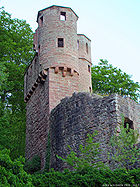 Neckarsteinach’s foremost sights are its four castles, which stand on crags or the slope leading down to the Neckar. They are the Vorderburg (“Fore-castle” or “Further Castle”), the Mittelburg (“Middle Castle”), the Hinterburg (“Hind-castle” or “Hinder Castle”) and the Schadeck (also called the Schwalbennest, or “Swallows’ Nest”). The castles were built between 1100 and 1230 by the Landschad von Steinach family, partly as a Worms or Speyer fief, partly as an allodial holding. In the Late Middle Ages
Neckarsteinach’s foremost sights are its four castles, which stand on crags or the slope leading down to the Neckar. They are the Vorderburg (“Fore-castle” or “Further Castle”), the Mittelburg (“Middle Castle”), the Hinterburg (“Hind-castle” or “Hinder Castle”) and the Schadeck (also called the Schwalbennest, or “Swallows’ Nest”). The castles were built between 1100 and 1230 by the Landschad von Steinach family, partly as a Worms or Speyer fief, partly as an allodial holding. In the Late Middle Ages
, some were owned by various other lords of the lower nobility. In the 16th century, they all found themselves back in the Landschads’ ownership. After the family died out in 1653, they were owned by a line of the von Metternichs, and after they, too, died out in 1753, the castles were held by the Bishoprics of Worms and Speyer. Eventually, with mediatization
in 1803, they passed to Hesse, which sold the Vorderburg into private ownership and relinquished the Mittelburg along with the now ruined Hinterburg to those who had inherited the allodial property, the Barons of Dorth, who later also acquired the Vorderburg, whereas they chose to give the Hinterburg ruin back to the state. The Mittelburg, which was built into a Renaissance
palace in the 16th century and Gothicized
in the 19th century, is nowadays home to the von Warsberg-Dorth family; the Vorderburg is the Warsberg forest administration’s seat. The Hinterburg and Schadeck are freely visitable to the public. Particularly worth seeing at the Schadeck is the view over the bow in the Neckar and the Dilsberg mountain fortress over on the other side.
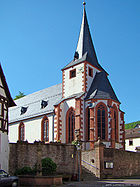
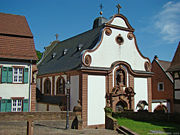
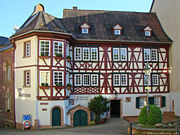
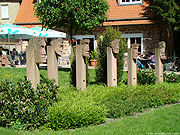
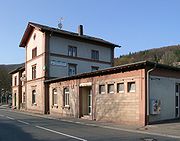
to Bad Friedrichshall
, and since 2003 also served half-hourly by the RheinNeckar S-Bahn
’s Lines 1 and 2. Between 1928 and 1981 there was a spur
running along the Steinach up to Schönau, but passenger service on it ended in 1969.
The predominant traffic artery today is Bundesstraße
37.
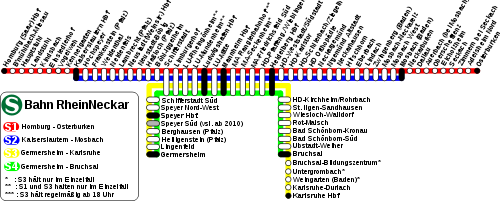
Tourism is run on the Neckar between Heidelberg and Eberbach
(and sometimes as far as Heilbronn
). Many guesthouses and overnight operations earn a living this way.
Neckar
The Neckar is a long river, mainly flowing through the southwestern state of Baden-Württemberg, but also a short section through Hesse, in Germany. The Neckar is a major right tributary of the River Rhine...
in the Bergstraße district
Kreis Bergstraße
Bergstraße is a Kreis in the south of Hesse, Germany. Neighboring districts are Groß-Gerau, Darmstadt-Dieburg, Odenwaldkreis, Rhein-Neckar-Kreis, the urban district Mannheim, the Rhein-Pfalz-Kreis, and the urban district of Worms...
in the southernmost part of Hesse
Hesse
Hesse or Hessia is both a cultural region of Germany and the name of an individual German state.* The cultural region of Hesse includes both the State of Hesse and the area known as Rhenish Hesse in the neighbouring Rhineland-Palatinate state...
, Germany
Germany
Germany , officially the Federal Republic of Germany , is a federal parliamentary republic in Europe. The country consists of 16 states while the capital and largest city is Berlin. Germany covers an area of 357,021 km2 and has a largely temperate seasonal climate...
, 15 km east of Heidelberg
Heidelberg
-Early history:Between 600,000 and 200,000 years ago, "Heidelberg Man" died at nearby Mauer. His jaw bone was discovered in 1907; with scientific dating, his remains were determined to be the earliest evidence of human life in Europe. In the 5th century BC, a Celtic fortress of refuge and place of...
.
Location
_1896.jpg)
Rhine Neckar Area
The Rhine-Neckar Metropolitan Region , often referred to as Rhein-Neckar-Triangle is a polycentric metropolitan region located in south western Germany, between the Frankfurt/Rhine-Main region to the North and the Stuttgart Region to the South-East.Rhine-Neckar has a population of some 2.4 million...
. It lies mainly on the Neckar’s north bank along the B 37 and the Neckartalbahn (railway) and is Hesse’s and the Bergstraße district’s southernmost town, 15 km east of Heidelberg. Along the former railway spur line to Schönau, a further population centre was built to the northwest, that is to say, behind the Burgberg (“Castle Mountain”). In the east of town lies a smaller industrial area, a shipyard
Shipyard
Shipyards and dockyards are places which repair and build ships. These can be yachts, military vessels, cruise liners or other cargo or passenger ships. Dockyards are sometimes more associated with maintenance and basing activities than shipyards, which are sometimes associated more with initial...
that arose out of shipbuilding
Shipbuilding
Shipbuilding is the construction of ships and floating vessels. It normally takes place in a specialized facility known as a shipyard. Shipbuilders, also called shipwrights, follow a specialized occupation that traces its roots to before recorded history.Shipbuilding and ship repairs, both...
, south of the B 37 on the Neckar marsh.
Neckarsteinach’s core lies southeast of and below the Vorderburg – one of four castles in town – and beginning in the 14th century it and the castle were girded by the same wall with the current town centre serving as the castle hamlet
Hamlet (place)
A hamlet is usually a rural settlement which is too small to be considered a village, though sometimes the word is used for a different sort of community. Historically, when a hamlet became large enough to justify building a church, it was then classified as a village...
. The community was bordered in the north and east by the river Steinach, in the south by the Neckar and in the west by the Burgberg. The landscape near Neckarsteinach is in particular characterized by the cone of the Bergfeste Dilsberg
Bergfeste Dilsberg
Bergfeste Dilsberg is a castle on a mountain over the Neckar River in Neckargemünd, Germany. The castle was built by the counts of Lauffen in the 12th century. In the 13th century it became the main castle for the counts. In the 14th century it became part of the Electoral Palatinate and received...
lying across the Neckar (in Neckargemünd
Neckargemünd
Neckargemünd is a town in Germany, in the district of Rhein-Neckar-Kreis, state of Baden-Württemberg. It lies on the Neckar, 10 km upriver from Heidelberg at the confluence with the river Elsenz. This confluence of the two rivers is the origin of the name, as Neckargemünd means confluence of...
, Baden-Württemberg
Baden-Württemberg
Baden-Württemberg is one of the 16 states of Germany. Baden-Württemberg is in the southwestern part of the country to the east of the Upper Rhine, and is the third largest in both area and population of Germany's sixteen states, with an area of and 10.7 million inhabitants...
), around which the Neckar flows in a broad bend.
Constituent communities
Neckarsteinach’s outlying centres of Darsberg and Grein are old settlements uphill to the north in the OdenwaldOdenwald
The Odenwald is a low mountain range in Hesse, Bavaria and Baden-Württemberg in Germany.- Location :The Odenwald lies between the Upper Rhine Rift Valley with the Bergstraße and the Hessisches Ried in the west, the Main and the Bauland in the east, the Hanau-Seligenstadt Basin – a subbasin of...
; the outlying centre of Neckarhausen lies 3 km upstream in the Neckar valley. It should not be confused with the like-named place, also in the Neckar valley, west of Heidelberg and across the river from Ladenburg
Ladenburg
Ladenburg is a town in the district of Rhein-Neckar-Kreis, in Baden-Württemberg, Germany. It is situated on the right bank of the Neckar, 10 km east of Mannheim, and 10 km northwest of Heidelberg.It has an old town from the Late Middle Ages...
; that Neckarhausen is a constituent community of Edingen-Neckarhausen
Edingen-Neckarhausen
Edingen-Neckarhausen is a municipality in the district of Rhein-Neckar-Kreis, in Baden-Württemberg, Germany. It is situated on the left bank of the Neckar.- Geography :...
.
Population: (as at: 31 December 2003)
- Neckarsteinach: 3,160
- Darsberg: 547
- Grein: 142
- Neckarhausen: 266
- Total: 4,115
Neighbouring communities
Neckarsteinach borders in the north on the town of HirschhornHirschhorn (Neckar)
Hirschhorn is a small town in the Bergstraße district of Hesse, Germany, and is known as "The Pearl of the Neckar valley”. Hirschhorn is a climatic health resort situated in the Geo-Naturpark Bergstraße-Odenwald.- Location :...
and the unincorporated area of Michelbuch, in the east on the town of Hirschhorn and the community of Schönbrunn
Schönbrunn (Baden)
Schönbrunn is a municipality in the Rhein-Neckar district, Baden-Württemberg, Germany. Distance from Heidelberg is 30 km east.-Districts:*Allemühl*Haag*Moosbrunn*Schönnbrunn*Schwanheim-Transport:...
, in the south on the town of Neckargemünd
Neckargemünd
Neckargemünd is a town in Germany, in the district of Rhein-Neckar-Kreis, state of Baden-Württemberg. It lies on the Neckar, 10 km upriver from Heidelberg at the confluence with the river Elsenz. This confluence of the two rivers is the origin of the name, as Neckargemünd means confluence of...
, and in the west on the town of Schönau
Schönau (Odenwald)
Schönau is a town in the district of Rhein-Neckar-Kreis, in Baden-Württemberg, Germany. It is situated in the Odenwald hills, 10 km northeast of Heidelberg. Schönau Abbey is located here....
(all three in the Rhein-Neckar-Kreis
Rhein-Neckar-Kreis
Rhein-Neckar-Kreis is a district in the northwest of Baden-Württemberg, Germany. Neighboring districts are Bergstraße, Odenwaldkreis, Neckar-Odenwald, Heilbronn, Karlsruhe, district-free Speyer, the Rhein-Pfalz-Kreis, and district-free Mannheim and Heidelberg.-History:The district was created in...
in Baden-Württemberg).
History
The earliest human habitation of what is now Neckarsteinach presumably took place in prehistoric times, for the water- and wood-rich area was ideal for hunting and fishing, and afforded a place sheltered from the cold north and east winds. In the 7th century, the area around Neckarsteinach belonged to the Lobdengau, and passed along with it to the high monastery at WormsWorms, Germany
Worms is a city in Rhineland-Palatinate, Germany, on the Rhine River. At the end of 2004, it had 85,829 inhabitants.Established by the Celts, who called it Borbetomagus, Worms today remains embattled with the cities Trier and Cologne over the title of "Oldest City in Germany." Worms is the only...
, when its fiefholder Bligger von Steinach
Bligger von Steinach
Bligger von Steinach was a the name of a series of feudal lords of Steinach, today Neckarsteinach in Baden-Württemberg, Germany. Collectively the noble family was known as the Edelfreien von Steinach. The family was influential, having close connections to the Holy Roman Emperor and to the...
was first mentioned. Worms or Bligger and his sons and grandsons build the four Neckarsteinach castles, whose history is so tightly bound to the town’s.
In the 14th century, the town was surrounded with defensive walls by the Landschad family of Steinach, turning the Vorderburg (one of the castles) and the town together into an enclosed fortification. Nevertheless, the town itself was only half owned by the keepers of the Vorderburg, while those of the Hinterburg (another of the castles) owned the other half. In 1377, Neckarsteinach was mentioned as a town for the first time, and at the same time it became an “open house” of Count Palatine Ruprecht, who could then use it in case of a feud
Feud
A feud , referred to in more extreme cases as a blood feud, vendetta, faida, or private war, is a long-running argument or fight between parties—often groups of people, especially families or clans. Feuds begin because one party perceives itself to have been attacked, insulted or wronged by another...
against anyone other than the Bishop of Worms as though he were the town’s fiefholder. In 1381 the first town hall was built, and in the early 15th century, Neckarsteinach received a town charter, which in the years that followed was changed and expanded. The oldest preserved town charter dates from 1537.
Since Hans III Landschad von Steinach became Lutheran in 1522, the Reformation
Protestant Reformation
The Protestant Reformation was a 16th-century split within Western Christianity initiated by Martin Luther, John Calvin and other early Protestants. The efforts of the self-described "reformers", who objected to the doctrines, rituals and ecclesiastical structure of the Roman Catholic Church, led...
was already fully in place in Neckarsteinach quite early on. In 1526, the Lutheran preacher Jakob Otter was working in town.
In the Thirty Years' War
Thirty Years' War
The Thirty Years' War was fought primarily in what is now Germany, and at various points involved most countries in Europe. It was one of the most destructive conflicts in European history....
, the town suffered heavily. The Catholic League
Catholic League (German)
The German Catholic League was initially a loose confederation of Roman Catholic German states formed on July 10, 1609 to counteract the Protestant Union , whereby the participating states concluded an alliance "for the defence of the Catholic religion and peace within the Empire." Modeled...
under Tilly, after conquering Ladenburg in the autumn of 1621 also took Neckarsteinach, whence the Dilsberg mountain fortress across the river was besieged
Siege
A siege is a military blockade of a city or fortress with the intent of conquering by attrition or assault. The term derives from sedere, Latin for "to sit". Generally speaking, siege warfare is a form of constant, low intensity conflict characterized by one party holding a strong, static...
in April 1622. After retreating for a short while to Sinsheim, the Catholic troops came back for the Battle of Wimpfen
Battle of Wimpfen
The Battle of Wimpfen was a battle in the Bohemian Revolt period of the Thirty Years' War on 6 May 1622 near Wimpfen. The forces of the Holy Roman Empire and Catholic League under Marshal Tilly and Gonzalo de Córdoba defeated the Protestant forces of General Ernst von Mansfeld and Georg Friedrich,...
and quartered themselves in the town, where the Plague then broke out. In 1631, the Bavaria
Bavaria
Bavaria, formally the Free State of Bavaria is a state of Germany, located in the southeast of Germany. With an area of , it is the largest state by area, forming almost 20% of the total land area of Germany...
n occupation troops were driven out by Swedish
Sweden
Sweden , officially the Kingdom of Sweden , is a Nordic country on the Scandinavian Peninsula in Northern Europe. Sweden borders with Norway and Finland and is connected to Denmark by a bridge-tunnel across the Öresund....
troops, before, in 1634, there were Imperial troops in town. Then once more came another wave of the Plague.
After the Landschad family of Steinach died out in 1653, the Bishoprics of Worms and Speyer at first oversaw the fief, with the latter living at the Hinterburg. In 1657, the episcopal fief was given to Wolf Heinrich Metternich von Burscheid, who had kinship with the Archpishop of Mainz, and who also acquired the allodial properties
Allodial title
Allodial title constitutes ownership of real property that is independent of any superior landlord, but it should not be confused with anarchy as the owner of allodial land is not independent of his sovereign...
from the Landschads’ legacy. Metternich was old-school – that is to say, Catholic – and encouraged other Catholics to come an settle in town. The Evangelical
Evangelical Church in Germany
The Evangelical Church in Germany is a federation of 22 Lutheran, Unified and Reformed Protestant regional church bodies in Germany. The EKD is not a church in a theological understanding because of the denominational differences. However, the member churches share full pulpit and altar...
church in Neckarsteinach therefore ended up housing up to three denominations from 1662 to1908. In the Nine Years' War (1688–1697), French
France
The French Republic , The French Republic , The French Republic , (commonly known as France , is a unitary semi-presidential republic in Western Europe with several overseas territories and islands located on other continents and in the Indian, Pacific, and Atlantic oceans. Metropolitan France...
, Saxon
Saxony
The Free State of Saxony is a landlocked state of Germany, contingent with Brandenburg, Saxony Anhalt, Thuringia, Bavaria, the Czech Republic and Poland. It is the tenth-largest German state in area, with of Germany's sixteen states....
, Brandenburgish
Margraviate of Brandenburg
The Margraviate of Brandenburg was a major principality of the Holy Roman Empire from 1157 to 1806. Also known as the March of Brandenburg , it played a pivotal role in the history of Germany and Central Europe....
and Bavarian troops passed through the Neckar valley and quartered there and are said to have made contributions.
After 1685, many Huguenot
Huguenot
The Huguenots were members of the Protestant Reformed Church of France during the 16th and 17th centuries. Since the 17th century, people who formerly would have been called Huguenots have instead simply been called French Protestants, a title suggested by their German co-religionists, the...
s – known locally as Welsche – who had been driven out of France for their beliefs, came to settle in Neckarsteinach. They were clothmakers and tanners, and with their skills, the town underwent an upswing offsetting some of the losses from the wars that had taken their toll.
In the early 18th century, Neckarsteinach was quarters and a field hospital site in the War of the Spanish Succession
War of the Spanish Succession
The War of the Spanish Succession was fought among several European powers, including a divided Spain, over the possible unification of the Kingdoms of Spain and France under one Bourbon monarch. As France and Spain were among the most powerful states of Europe, such a unification would have...
(1701–1714), the War of the Polish Succession
War of the Polish Succession
The War of the Polish Succession was a major European war for princes' possessions sparked by a Polish civil war over the succession to Augustus II, King of Poland that other European powers widened in pursuit of their own national interests...
(1733–1738) and the War of the Austrian Succession
War of the Austrian Succession
The War of the Austrian Succession – including King George's War in North America, the Anglo-Spanish War of Jenkins' Ear, and two of the three Silesian wars – involved most of the powers of Europe over the question of Maria Theresa's succession to the realms of the House of Habsburg.The...
(1740–48) for troops engaged in these wars.
In 1699, ownership of Neckarsteinach passed by matrilineal inheritance to Caspar Hugo von Metternich zu Müllenark. His heirs later pledged the ownership of Neckarsteinach in 1738 to the baronial von Hundheim heirs, who were likewise set up as local lords once it became clear that the Metternichs could no longer redeem their pledge. Each lord then hired his own Schultheiß (roughly, “sheriff”), resulting in bitter quarrels, not only between the lords, but also among the townsfolk, over just who was in charge. Only in 1750 did Hugo Franz Wolfgang Metternich manage to allay the town’s concerns by uniting lordly authority in himself. He, however, died only four years later, whereupon both Electoral Palatinate and the Bishopric of Worms
Bishopric of Worms
The Bishopric of Worms was an ecclesiastical principality of the Holy Roman Empire. Located on both banks of the Rhine around Worms just north of the union of that river with the Neckar, it was largely surrounded by the Palatinate. Worms had been the seat of a bishop from Roman times...
laid claim to the town, each taking palpable measures to ensure its claim. The town passed first to Electoral Palatinate, though through Imperial mandate it was given to the monasteries at Worms and Speyer in 1763. With mediatization
Mediatization
Mediatisation is the loss of imperial immediacy. Broadly defined it is the subsumption of one monarchy into another monarchy in such a way that the ruler of the annexed state keeps his sovereign title and, sometimes, a measure of local power...
in 1803, Neckarsteinach became part of Hesse.
In 1842 and 1843, the state road from Eberbach to Heidelberg was built, for which the town wall had to be breached. In 1878 chain-driven shipping began on the Neckar, and the next year, the Neckartalbahn (railway) reached town.
Town council
The municipal election held on 26 March 2006 yielded the following results:| Parties and voter communities | % 2006 |
Seats 2006 |
% 2001 |
Seats 2001 |
|
| CDU | Christian Democratic Union of Germany | 25.8 | 5 | 31.2 | 7 |
| SPD | Social Democratic Party of Germany Social Democratic Party of Germany The Social Democratic Party of Germany is a social-democratic political party in Germany... |
42.8 | 8 | 46.4 | 11 |
| FWG | Freie Wählergemeinschaft | 31.4 | 6 | 22.4 | 5 |
| Total | 100.0 | 19 | 100.0 | 23 | |
| Voter turnout in % | 55.4 | 57.9 | |||
The town executive (Magistrat) is made up of 6 councillors. Two seats each are allotted to the SPD, the FWG and the CDU.
Mayor
Mayor Eberhard Petri was reëlected on 26 March 2006 with 73.8% of the vote.The chief councillor and deputy mayor is Elisabeth Hinz (FWG).
Name and coat of arms
The town draws its name from a feature in the local geography. It is here that the Steinach, a brook from the Odenwald, empties into the NeckarNeckar
The Neckar is a long river, mainly flowing through the southwestern state of Baden-Württemberg, but also a short section through Hesse, in Germany. The Neckar is a major right tributary of the River Rhine...
, and the town’s name is simply a compound of those two names.
The town’s arms
Coat of arms
A coat of arms is a unique heraldic design on a shield or escutcheon or on a surcoat or tabard used to cover and protect armour and to identify the wearer. Thus the term is often stated as "coat-armour", because it was anciently displayed on the front of a coat of cloth...
refer to the Minnesänger
Minnesang
Minnesang was the tradition of lyric and song writing in Germany which flourished in the 12th century and continued into the 14th century. People who wrote and performed Minnesang are known as Minnesingers . The name derives from the word minne, Middle High German for love which was their main...
Bligger von Steinach (fl. 1200), who was also a local nobleman, and even at the time bore arms with the harp as a charge
Charge (heraldry)
In heraldry, a charge is any emblem or device occupying the field of an escutcheon . This may be a geometric design or a symbolic representation of a person, animal, plant, object or other device...
.
Town partnerships
Pargny-sur-SaulxPargny-sur-Saulx
Pargny-sur-Saulx is a commune in the Marne department in north-eastern France.Pargny-sur-Saulx is known for its tiles, which are exported sometimes to Singapore, giving it the nickname "the city of the tiles"...
, Marne
Marne
Marne is a department in north-eastern France named after the river Marne which flows through the department. The prefecture of Marne is Châlons-en-Champagne...
, France
France
The French Republic , The French Republic , The French Republic , (commonly known as France , is a unitary semi-presidential republic in Western Europe with several overseas territories and islands located on other continents and in the Indian, Pacific, and Atlantic oceans. Metropolitan France...
Grein
Grein
Grein is a municipality in the district Perg in Upper Austria, Austria....
an der Donau
Danube
The Danube is a river in the Central Europe and the Europe's second longest river after the Volga. It is classified as an international waterway....
, Perg
Perg (district)
Bezirk Perg is a district of the state ofUpper Austria in Austria.-Municipalities:Towns are indicated in boldface; market towns in italics; suburbs, hamlets and other subdivisions of a municipality are indicated in small characters.*Allerheiligen im Mühlkreis*Arbing*Bad...
, Austria
Austria
Austria , officially the Republic of Austria , is a landlocked country of roughly 8.4 million people in Central Europe. It is bordered by the Czech Republic and Germany to the north, Slovakia and Hungary to the east, Slovenia and Italy to the south, and Switzerland and Liechtenstein to the...
Four castles

Late Middle Ages
The Late Middle Ages was the period of European history generally comprising the 14th to the 16th century . The Late Middle Ages followed the High Middle Ages and preceded the onset of the early modern era ....
, some were owned by various other lords of the lower nobility. In the 16th century, they all found themselves back in the Landschads’ ownership. After the family died out in 1653, they were owned by a line of the von Metternichs, and after they, too, died out in 1753, the castles were held by the Bishoprics of Worms and Speyer. Eventually, with mediatization
Mediatization
Mediatisation is the loss of imperial immediacy. Broadly defined it is the subsumption of one monarchy into another monarchy in such a way that the ruler of the annexed state keeps his sovereign title and, sometimes, a measure of local power...
in 1803, they passed to Hesse, which sold the Vorderburg into private ownership and relinquished the Mittelburg along with the now ruined Hinterburg to those who had inherited the allodial property, the Barons of Dorth, who later also acquired the Vorderburg, whereas they chose to give the Hinterburg ruin back to the state. The Mittelburg, which was built into a Renaissance
Renaissance
The Renaissance was a cultural movement that spanned roughly the 14th to the 17th century, beginning in Italy in the Late Middle Ages and later spreading to the rest of Europe. The term is also used more loosely to refer to the historical era, but since the changes of the Renaissance were not...
palace in the 16th century and Gothicized
Gothic Revival architecture
The Gothic Revival is an architectural movement that began in the 1740s in England...
in the 19th century, is nowadays home to the von Warsberg-Dorth family; the Vorderburg is the Warsberg forest administration’s seat. The Hinterburg and Schadeck are freely visitable to the public. Particularly worth seeing at the Schadeck is the view over the bow in the Neckar and the Dilsberg mountain fortress over on the other side.
Other buildings

- The Neckarsteinach EvangelicalEvangelical Church in GermanyThe Evangelical Church in Germany is a federation of 22 Lutheran, Unified and Reformed Protestant regional church bodies in Germany. The EKD is not a church in a theological understanding because of the denominational differences. However, the member churches share full pulpit and altar...
Church goes back to the town’s original church and was newly built in 1483 in the Late GothicGothic architectureGothic architecture is a style of architecture that flourished during the high and late medieval period. It evolved from Romanesque architecture and was succeeded by Renaissance architecture....
style by Blicker XIV Landschad von Steinach. The church was reformed in the early 16th century, but then from 1662 to 1908 it was used as an interdenominational church for up to three denominations. Among the church’s most important art treasures are many epitaphs of the Landschad von Steinach family and replicas of the stained glassStained glassThe term stained glass can refer to coloured glass as a material or to works produced from it. Throughout its thousand-year history, the term has been applied almost exclusively to the windows of churches and other significant buildings...
windows from 1483.

- The Catholic Herz-Jesu-Kirche (“Jesus’s Heart Church”) was built in Neo-Baroque style between 1906 and 1908 by Prof. Friedrich Pützer. The main altarAltarAn altar is any structure upon which offerings such as sacrifices are made for religious purposes. Altars are usually found at shrines, and they can be located in temples, churches and other places of worship...
from 1750 shows Saint StephenSaint StephenSaint Stephen The Protomartyr , the protomartyr of Christianity, is venerated as a saint in the Roman Catholic, Anglican, Lutheran, Oriental Orthodox and Eastern Orthodox Churches....
in the middle and came originally from Saint Stephen’s Church (Catholic) in MainzMainzMainz under the Holy Roman Empire, and previously was a Roman fort city which commanded the west bank of the Rhine and formed part of the northernmost frontier of the Roman Empire...
-Gonsenheim. The side altars were originally in the church now used as an EvangelicalEvangelical Church in GermanyThe Evangelical Church in Germany is a federation of 22 Lutheran, Unified and Reformed Protestant regional church bodies in Germany. The EKD is not a church in a theological understanding because of the denominational differences. However, the member churches share full pulpit and altar...
church, but formerly as an interdenominational church before the Catholic Church was built, and date from 1711.

- The town hall was built in 1861 and 1862 on the same site as the old one from the 16th century which had burnt down. The first town hall, from the 14th century, is believed to have stood elsewhere.
- Neckarsteinach has a wealth of historic buildings. Besides remains of the town wall from the 14th century, the mediaevalMiddle AgesThe Middle Ages is a periodization of European history from the 5th century to the 15th century. The Middle Ages follows the fall of the Western Roman Empire in 476 and precedes the Early Modern Era. It is the middle period of a three-period division of Western history: Classic, Medieval and Modern...
Bliggergasse (lane) can be named, as can the timber-frameTimber framingTimber framing , or half-timbering, also called in North America "post-and-beam" construction, is the method of creating structures using heavy squared off and carefully fitted and joined timbers with joints secured by large wooden pegs . It is commonplace in large barns...
house Ambtmann, the old synagogueSynagogueA synagogue is a Jewish house of prayer. This use of the Greek term synagogue originates in the Septuagint where it sometimes translates the Hebrew word for assembly, kahal...
on Hirschgasse and the historic timber-frame ensemble on Kirchenstraße. The lower town has been floodFloodA flood is an overflow of an expanse of water that submerges land. The EU Floods directive defines a flood as a temporary covering by water of land not normally covered by water...
ed many times, witnessing which are the high-water marks that can be seen on Hirschgasse. The highest flood came in 1824; the latest in 1993. - In the outlying centre of Darsberg is found the historic Sebastianskapelle (“Sebastian’s chapel”).
Park

- Nibelungen-Park, remodelled in 1998 with sandstoneSandstoneSandstone is a sedimentary rock composed mainly of sand-sized minerals or rock grains.Most sandstone is composed of quartz and/or feldspar because these are the most common minerals in the Earth's crust. Like sand, sandstone may be any colour, but the most common colours are tan, brown, yellow,...
sculptureSculptureSculpture is three-dimensional artwork created by shaping or combining hard materials—typically stone such as marble—or metal, glass, or wood. Softer materials can also be used, such as clay, textiles, plastics, polymers and softer metals...
s by sculptor Paul August Wagner from the Seckach Sculpture Park.
Regular events
- On the first weekend in March, the Kleine Buchmesse im Neckartal (book fair) is held at the Bürgerhaus zum Schwanen (community centre).
- In the outlying centre of Darsberg on the Thursday during CarnivalCarnivalCarnaval is a festive season which occurs immediately before Lent; the main events are usually during February. Carnaval typically involves a public celebration or parade combining some elements of a circus, mask and public street party...
– known locally as Fastnacht – a witches’ parade is staged. To a witches’ dance and GuggenmusikGuggenmusikGuggenmusik is a term usually used in the Alemannic region of Switzerland, Austria and southern Germany, also as "Guggemoseg", "Guuggemusig" or "Chatzemusig", for a Carnival marching band.- Definition :...
, a Feuerrad – a “firewheel” made of strawStrawStraw is an agricultural by-product, the dry stalks of cereal plants, after the grain and chaff have been removed. Straw makes up about half of the yield of cereal crops such as barley, oats, rice, rye and wheat. It has many uses, including fuel, livestock bedding and fodder, thatching and...
– is rolled. - A fortnight before EasterEasterEaster is the central feast in the Christian liturgical year. According to the Canonical gospels, Jesus rose from the dead on the third day after his crucifixion. His resurrection is celebrated on Easter Day or Easter Sunday...
, the traditional Sommertagszug (“Summer Day Parade”) is held. - A fortnight after WhitsunWhitsunWhitsun is the name used in the UK for the Christian festival of Pentecost, the seventh Sunday after Easter, which commemorates the descent of the Holy Spirit upon Christ's disciples...
(the first Sunday after Trinity SundayTrinity SundayTrinity Sunday is the first Sunday after Pentecost in the Western Christian liturgical calendar, and the Sunday of Pentecost in Eastern Christianity...
) comes the Kerwe (church consecration festival) with a baked-fish festival. - On the last Saturday in July, Tag des Gastes (“Guest’s Day”) is celebrated with floodlighting on the four castles.
- On the first weekend in AdventAdventAdvent is a season observed in many Western Christian churches, a time of expectant waiting and preparation for the celebration of the Nativity of Jesus at Christmas. It is the beginning of the Western liturgical year and commences on Advent Sunday, called Levavi...
, the Christmas Market is held in the lower Old Town.
Economy and infrastructure

Transport
Neckarsteinach and the outlying centre of Neckarhausen lie on the Neckartalbahn opened in 1879 and running from Heidelberg by way of MosbachMosbach
Mosbach is the capital of the Neckar-Odenwald district in the north of Baden-Württemberg, Germany, about 58 km east of Heidelberg. Its geographical position is 49.21'N 9.9'E....
to Bad Friedrichshall
Bad Friedrichshall
Bad Friedrichshall is a town in the district of Heilbronn in Baden-Württemberg in southern Germany. It is situated at the confluence of the Jagst and the Kocher into the Neckar, 10 km north of Heilbronn...
, and since 2003 also served half-hourly by the RheinNeckar S-Bahn
RheinNeckar S-Bahn
The Rhine-Neckar S-Bahn forms the backbone of the urban rail transport network of the Rhine Neckar Area, including the cities of Mannheim, Heidelberg and Ludwigshafen....
’s Lines 1 and 2. Between 1928 and 1981 there was a spur
Branch line
A branch line is a secondary railway line which branches off a more important through route, usually a main line. A very short branch line may be called a spur line...
running along the Steinach up to Schönau, but passenger service on it ended in 1969.
The predominant traffic artery today is Bundesstraße
Bundesstraße
Bundesstraße , abbreviated B, is the denotation for German and Austrian national highways.-Germany:...
37.

Established businesses
Goods transport on the Neckar has a long tradition in town. There are still shipowner families.Tourism is run on the Neckar between Heidelberg and Eberbach
Eberbach (Baden)
Eberbach is a town in Germany, in northern Baden-Württemberg, located 33 km east of Heidelberg. It belongs to the Rhein-Neckar-Kreis. Its sister city is Ephrata, United States.- Location :...
(and sometimes as far as Heilbronn
Heilbronn
Heilbronn is a city in northern Baden-Württemberg, Germany. It is completely surrounded by Heilbronn County and with approximately 123.000 residents, it is the sixth-largest city in the state....
). Many guesthouses and overnight operations earn a living this way.
Education
- Freiherr-vom-Stein-Schule, with primary school, HauptschuleHauptschuleA Hauptschule is a secondary school in Germany and Austria, starting after 4 years of elementary schooling, which offers Lower Secondary Education according to the International Standard Classification of Education...
and RealschuleRealschuleThe Realschule is a type of secondary school in Germany, Austria, Switzerland, and Liechtenstein. It has also existed in Croatia , Denmark , Sweden , Hungary and in the Russian Empire .-History:The Realschule was an outgrowth of the rationalism and empiricism of the seventeenth and...
.
Famous people
- Bligger II von Steinach, mediaeval Minnesänger
- Jakob Otter, reform theologian, first Lutheran clergyman of Neckarsteinach
- Valentin Peter Feuerstein, painter and stained glass maker from Neckarsteinach
- Kai Herdling, professional footballer (TSG 1899 Hoffenheim, SV Waldhof MannheimSV Waldhof MannheimSV Waldhof Mannheim is a German association football club, located in Mannheim, Baden-Württemberg. The club today has a membership of over 2,400.-History:...
) grew up in Darsberg - Otto BartningOtto BartningOtto Bartning was a Modernist German architect, architectural theorist and teacher. In his early career he developed plans with Walter Gropius for the establishment of the Bauhaus. He was a member of Der Ring...
, architectArchitectAn architect is a person trained in the planning, design and oversight of the construction of buildings. To practice architecture means to offer or render services in connection with the design and construction of a building, or group of buildings and the space within the site surrounding the...
and town plannerUrban planningUrban planning incorporates areas such as economics, design, ecology, sociology, geography, law, political science, and statistics to guide and ensure the orderly development of settlements and communities....
, lived eleven years in Neckarsteinach and planned the upper neighbourhood for Germans expelled from their landsExpulsion of Germans after World War IIThe later stages of World War II, and the period after the end of that war, saw the forced migration of millions of German nationals and ethnic Germans from various European states and territories, mostly into the areas which would become post-war Germany and post-war Austria...
Further reading
- Walter Möller u. Karl Krauß: Neckarsteinach, seine Herren, die Stadt und die Burgen, Mainz 1928
- Christoph Bühler: Burgen der Kurpfalz. Bergstraße und Neckartal. Heidelberger Verlagsanstalt, Heidelberg 1990. S. 107 ff. ISBN 3-89426-012-2
- Jochen Goetze (Text) und Werner Richner (Fotografie): Burgen im Neckartal. Braus, Heidelberg 1989. S. 58 ff. ISBN 3-925835-52-0
- Elisabeth Hinz: Neckarsteinach gestern und heute. Heidelberg: Heidelberger Verlagsanstalt, 1989. ISBN 3-89426-031-9

